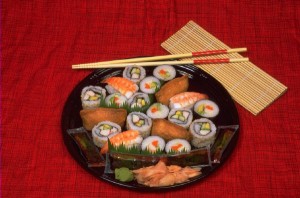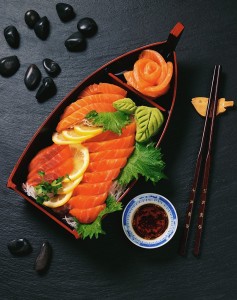 Over the holidays, I was playing a board game called “Wasabi!” with friends. The object of the game is to build the different sushi recipes you are assigned, using various ingredients available in the game’s ‘kitchen’: rice, avocado, tofu, daikon radish, cucumber, other vegetables as well as the various seafood, such as shrimp, scallop, eel, salmon and even blowfish. If you successfully build your recipe without interference by other players building their recipes on the same mat, you earn points. Do this in the exact order the ingredients are listed in the recipe, and you earn ‘wasabi cubes’, increasing your points and chance of winning the game.
Over the holidays, I was playing a board game called “Wasabi!” with friends. The object of the game is to build the different sushi recipes you are assigned, using various ingredients available in the game’s ‘kitchen’: rice, avocado, tofu, daikon radish, cucumber, other vegetables as well as the various seafood, such as shrimp, scallop, eel, salmon and even blowfish. If you successfully build your recipe without interference by other players building their recipes on the same mat, you earn points. Do this in the exact order the ingredients are listed in the recipe, and you earn ‘wasabi cubes’, increasing your points and chance of winning the game.
Playing the game as a nutritionist and food-lover, I realized it was missing some essential, health-protecting ingredients that are traditionally part of a sushi/sashimi meal. It concerned me to think of those who eat these works of art regularly but don’t fully participate in the traditional way of eating it. That is to say, if you eat sashimi (raw fish sushi) you are taking a health risk if you skip these 3 ingredients:
1. Pickled Ginger: this hot condiment served in thin, pinkish slices stimulates stomach acid, which is needed for digestion of dietary proteins. In effect, the low pH of stomach acid means it is capable of killing the pathogenic microbes that you may inadvertently consume when eating raw foods. Additionally, like most other condiments, ginger heats the body upon consuming what is otherwise cooling food.
2. Soy sauce: This fermented, salty condiment is not just a flavour enhancer; it’s also an anti-microbial. Remember, before refrigeration (and electricity), societies of the warmer climates used salt as a preservative to prevent food from spoilage by moulds, bacteria and fungi. Perhaps you’ve seen someone use table salt on a freshwater leech (a.k.a. ‘bloodsucker’) to force it to detach from the skin. It works every time. Could the Japanese have had this in mind when they started serving soy sauce with sushi?

3. Wasabi: This variety of horseradish, served pureed, looks green and is known and feared for its extreme heat and tongue-biting quality. Only miniscule amounts are palatable to me; I used to shake my head in disbelief when I purchased a to-go tray of California rolls at the local supermarket and saw the large lump of green wasabi accompanying just 6 pieces of sushi! But here’s the significance of the wasabi: it is one of the few natural ingredients proven to kill the ulcer-associated bacterium helicobacter pylori! If it can kill bacteria as acid-resistant as h.pylori, then it is surely a good defense against some of the common parasites found in ill-prepared sushi.
Concerned about getting parasites? Sushi is just one of the high-risk foods when it comes to this health problem but the Japanese have already dealt with this effectively in a preventative manner—by serving these 3 anti-microbial ingredients with these culinary works of art. Don’t eat sushi without them.
Which Japanese condiment is YOUR favourite?